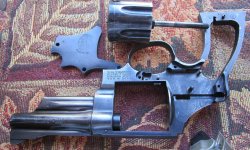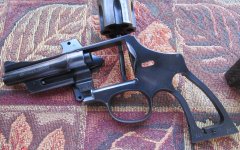I recently acquired this 28-2 (N591xxx) as a project gun. It has great mechanics but very thin blue and several spots of shallow corrosion. I have a friend with a hot tank and I'm thinking of having him re-blue this thing after I remove the old finish and polish the minor rough spots.
One question concerns the removal of the ejector rod forward lock up and spring in the ER shroud. Can the process be done without driving the retaining pin out for removal of the other two parts?
The other question is, is it OK to leave the barrel on the frame?
I've done this on an old Savage 23A but this is a different animal.
One question concerns the removal of the ejector rod forward lock up and spring in the ER shroud. Can the process be done without driving the retaining pin out for removal of the other two parts?
The other question is, is it OK to leave the barrel on the frame?
I've done this on an old Savage 23A but this is a different animal.



